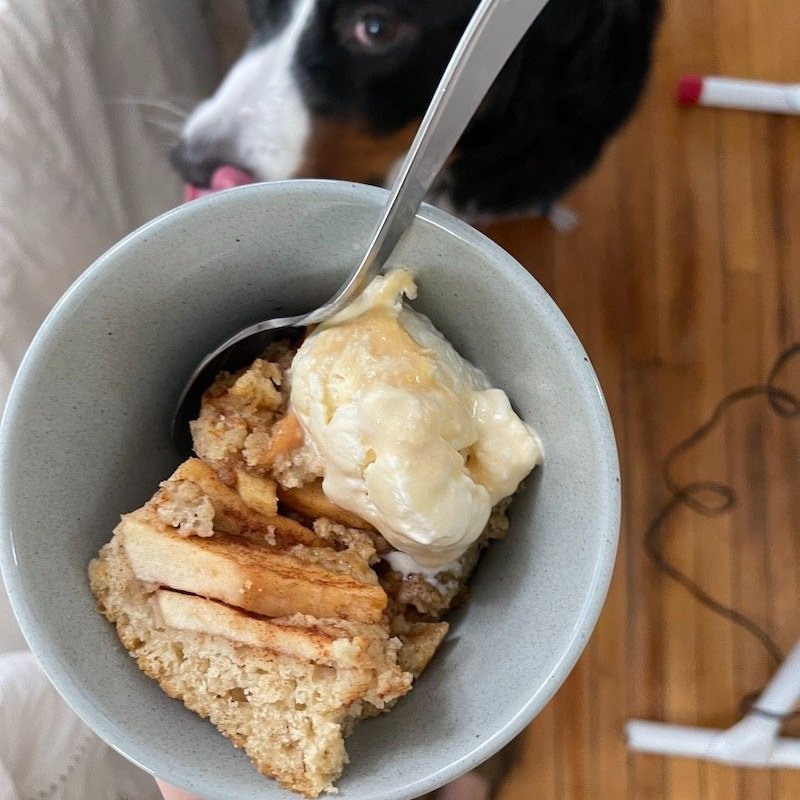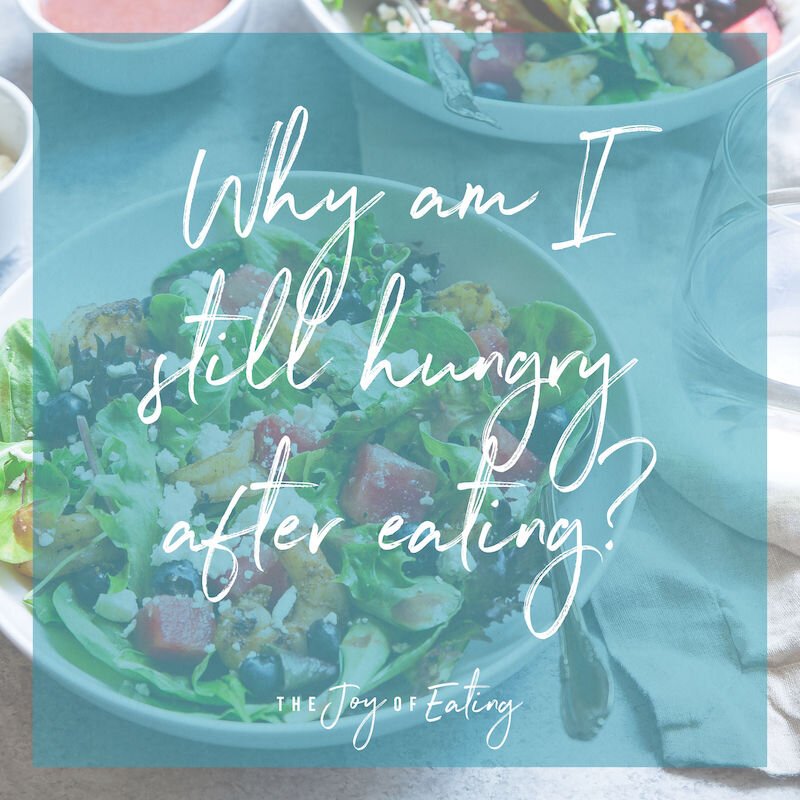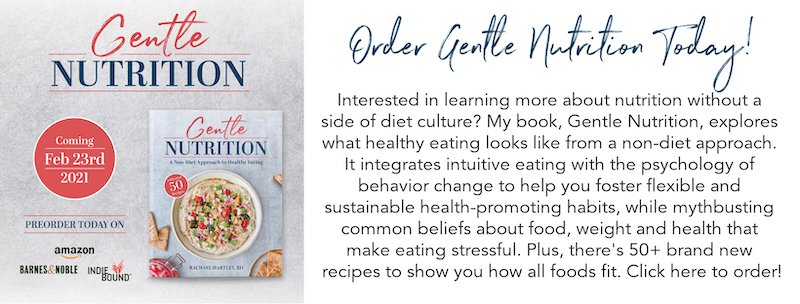How To Plan a Satisfying Meal
Thanks to diet culture, most of us have learned meal planning centered around eating as little as possible without keeling over. Rarely are we taught how to plan a satisfying meal. This post shares one of my favorite tools to teach clients for meal planning for satisfaction.
As I mentioned in my last blog post on the restrict-binge cycle, most of our clients sign up to work with us because they're concerned about what they believe is overeating. However, as the dieting pendulum analogy I shared explains, in most cases the “overeating” is caused by restriction, both intentional and unintentional.
Because weight is so tied up in how we view health, most of us have learned that “healthy” eating involves eating as little as possible without keeling over. We learn how to cut calories in recipes and practice portion control and which food groups to cut, but rarely are we taught how to plan and prepare a satisfying meal. Most of my clients have very little insight into what it looks like to eat enough food.
So what does it look like to eat enough food at mealtime? It depends! Our energy needs change from day to day, therefore our food needs change from day to day. This is where intuitive eating skills help you decide how much and what types of food to eat in order for you to feel satisfied. However, there are some loose guidelines that I’ll share in this post, which may be helpful as you navigate intuitive eating. In my book, Gentle Nutrition, I expand on this planning tool and include 50+ recipes that were created with the goal of satisfaction in mind.
How to Plan a Satisfying Meal
To help my clients stress less about food choices, I introduce them to a flexible tool for planning satisfying meals that I call “The Gang.” I stole the term from a dear friend and fellow non- diet dietitian Kylie Mitchell, who, when creating a meal that contains all of the components for satisfaction proclaims, “The gang is all here!”
The Gang is essentially a checklist you can run through to make sure your meal has what it needs for satisfaction. When The Gang is present on your plate, you’re more likely to leave that meal feeling satisfied and adequately fed. When you feel satisfied, not just full, your brain is able to focus on things other than the drive to eat. A nice thing for, ya know, living a well rounded life that doesn’t center around food.
Gang’s all here! I’ve got carbs from brown rice, protein from Beyond Beef (cooked with scallions and Omsom’s yummy bulgogi sauce), fat from the sesame oil I used to saute napa cabbage and kimchi. It was a tasty, satisfying and quick meal that used up some leftover cabbage, cucumbers and scallions I had in the fridge, and Beyond Beef from the freezer.
The Gang
The Leader of the Pack: Carbohydrates
Thanks to diet culture, carbs are often thought of as optional. In reality, glucose from carbohydrate is the body’s main source of energy. Carbs are used by every cell in the body, and are the only source of fuel the brain can use. Because the brain uses about 20 percent of the body’s energy, your body has a high demand for carbohydrate, even when it is at rest - your body may not be moving, but your brain is always hard at work (unless you’re dead, which if you’re reading this, presumably you are not).
Current dietary guidelines recommend that approximately 45 to 65 percent of energy intake should come from carbohydrates. That’s right - it’s carbs, the most demonized of nutrients, that most people should be eating the greatest quantity of.
Because the body and brain have a high need for glucose from carbohydrate, your body has built-in systems that make sure it’s getting enough. If you’re not, it’ll let you know, often through intense hunger, anxiety, and obsessive thoughts about food. Just think about how you feel when your blood sugar is low: dizzy, shaky, fatigued, and very ready to demolish a box of cookies.
To satisfy your body’s carbohydrate needs and plan a satisfying meal, include a carbohydrate source. While there are smaller amounts of carbohydrates in a lot of foods, for meal planning purposes I generally recommend including a source of carbs from one of the following foods:
Grains - anything made with flour (i.e. bread, pasta, baked goods, tortillas, cereals, crackers, pretzels, etc), rice, quinoa, oats, corn, millet, teff, barley, buckwheat, etc.
Beans and pulses - black beans, chickpeas, lentils, butter beans, pinto beans, etc.
Starchy vegetables - potatoes, sweet potatoes, winter squash, parsnips, etc.
You are allowed to have more than one carb at meals! In fact, for many cultures multiple carbs is a staple - think beans and rice in Central America and the Caribbean or dal with flatbread in India. This takeout meal from a favorite Lebanese restaurant got carbs from pita, hummus, and falafel, protein from the cheese and falafel, and fats from the salad dressing, cheese, dips, olives and falafel.
Sidekick #1: Protein
Protein-containing food is another member of The Gang to include as part of your meals. You probably already know that protein is important: diet culture has made us believe protein has an almost mythical health-promoting status and pushes massive quantities of it in the name of weight loss, muscle building, and satiety. No wonder most people are fearful of eating too much fat or carbohydrate but have no such anxiety around protein.
As with many beliefs in the world of nutrition, this one contains a kernel of truth, which is that protein plays a crucial role in promoting satiety. When you eat protein, your body breaks it down into amino acids, which are then absorbed into the bloodstream. As the level of amino acids in the blood rises, the hypothalamus releases the hormones that signal you to stop eating. Compared to fat and carbohydrate, protein promotes the greatest release of peptide YY, a hormone that reduces appetite, and also decreases levels of ghrelin, a hormone that stimulates appetite.
That said, protein isn’t magic. Let’s leave room on the plate for other foods. When it comes to planning a satisfying meal or choosing what to eat in a situation where you might have to go a while before eating again, knowing about protein’s effect on satiety helps you take advantage of it. But there’s no need to load up on huge quantities of protein at every meal.
To plan a satisfying meal, try to include a source of protein from one of the following foods:
Meat and poultry
Fish and seafood
Eggs
Dairy - milk, yogurt, cheese
Beans and pulses - black beans, chickpeas, lentils, butter beans, pinto beans, etc.
Nuts and seeds
Soy products - tofu, tempeh, soybeans
Meat alternatives - Beyond/Impossible Burger, foods made with wheat gluten/seitan, etc
Protein doesn’t necessarily have to be a piece of meat. It can be plant-based proteins, or as in this Brussels sprouts spaghetti carbonara, smaller things adding up to provide a satisfying amount of protein. This dish got protein from parmesan cheese and egg (carbonara uses a good bit of each to make a sauce) and bacon.
Sidekick #2: Fat
Along with carbohydrate and protein, a satisfying meal requires fat. When you eat a meal that contains fat, sensors in the small intestine detect the higher-fat contents leaving the stomach. In response, the body keeps food in your stomach longer by releasing the hormones that slow down gastric emptying. This is helpful both for stabilizing blood glucose levels (because the carbs from your meal will also leave your stomach more slowly) and for keeping you full longer. Cholecystokinin, a hormone that stimulates the digestion of fat and protein, also alerts the hypothalamus to signal satiety, similar to how the hypothalamus detects rising blood glucose after a meal and lowers hunger cues in response.
As I’ve said a thousand times before, human beings are designed to be flexible around food, and there’s no exact amount of fat you need to include as part of your meals. Some meals will be naturally higher in fat than others, and that’s okay. As a general guideline, I usually recommend including at least one or two sources of fat in each meal. Consider how much fat to use from a culinary perspective rather than a nutritional one.
Here’s examples of fats to use:
Oils - olive, canola, sunflower, vegetable, soybean, sesame, peanut, etc
Butter, lard, shortening and margarine
Full fat and 2% (reduced fat) dairy
Eggs
Meat, poultry and some types of fish
Nuts & seeds
Avocado
This meal has The Gang - carbs from steamed white rice, protein from salmon, volume from the satisfying portions + kale salad, pleasure factor from - well, look at it. It’s pretty delish. And finally, there’s fat from a few different sources that all provide different culinary purposes - oil in the chili crisp which dresses up the simply roasted salmon, sesame oil in the kale salad dressing which softens the kale, peanuts in the kale salad for crunch, and finally parmesan cheese in the salad, because that’s what the recipe called for and it was tasty and also added salty, umami flavor.
The Generous Friend: Volume
Not only does the body want all of the macronutrients for a satisfying meal, but it also wants enough of a volume of food to feel full. This is because along with the mechanisms that sense the presence of fat, protein, and carbohydrate entering the bloodstream, the stomach also has stretch receptors that are triggered as it fills. Think of the stomach like your bladder - just as you feel the urge to pee as your bladder stretches, you’ll feel less hungry as your stomach stretches.
A meal can have fat, protein, and carbohydrate, and yet if you’re not eating enough food, it won’t be satisfying. Frozen meals, especially diet ones, are a good example of this. Most have a combination of food groups, but provide a snack-like quantity of food that’s rarely satisfying as a full meal by itself.
Plating an amount of food that you wouldn’t feel like a jerk for serving someone else is a helpful way to make sure you’re getting a good volume of food. Including produce (fruit or vegetable) at your meals is another way to get a satisfying volume, and provide some gentle nutrition by adding to the variety of foods on your plate. The fiber in produce also helps keep food in your stomach longer, helping you feel satiated until your next meal or snack.
This plate of bacon, eggs scrambled with veggies, English muffin (New England style FTW!), berries and potato hash had The Gang, but the volume was a little small for me to feel satisfied, since I was pretty hungry by the time brunch came around. So, I went back and got a seconds.
The Fun Friend: Pleasure
Last, but certainly not least, is pleasure. So far, I have discussed the biological triggers for fullness. However, we’re aiming for satisfaction here, which means eating a meal that meets your physical and emotional needs. To do that, consider pleasure when deciding what to eat.
There are many ways to bring pleasure into your meals, but the most important is simply pausing to ask yourself what sounds good before eating. It can be a difficult question for many people to answer, especially those who have spent a long time dieting and eating what they “should” rather than what they want. But over time you will become more attuned to taste preferences. Another way to incorporate pleasure into meals is to think of including a “serving of pleasure.” This might look like pairing a simply cooked dinner with a tasty sauce, topping your veggies with butter or cheese, or simply having dessert after eating.
That doesn’t mean that every meal has to be a gourmet meal experience. Sometimes you just have to eat what’s available, or other needs trump pleasure in the moment. For example, you might be sick with diarrhea, and eat a bland foods for awhile to help your stomach settle. Or maybe you have a busy day at work, and you’re not in the mood for what you packed for lunch, but it’s convenient and you need to eat. These aren’t wrong! When you know that more tasty food is coming in the future, it feels OK to eat for pure energy purposes.
The lunch before this serving of apple skillet cake and salted caramel ice cream was kinda meh. It had The Gang, but was leftovers I was feel pretty sick of. So to feel satisfied, I decided dessert was in order for a serving of pleasure!
Flexibility in Meal Planning
I hope The Gang is a helpful tool for you in planning a satisfying meal, but please remember it is just - a tool and not a rule. Sometimes what you’re in the mood for, or what’s available, doesn’t have all these components, and that’s OK. For example, you might be in the mood for a simple plate of pasta with tomato sauce, or a crisp salad topped with grilled chicken, cheese and nuts. While yes, the pasta with tomato sauce would be more satiating with protein, and the salad would be more satiating with a roll on the side, perhaps those foods aren’t available, or what you want in the moment. It’s OK to just eat what you want - but do keep in mind that it’s likely you’ll be hungrier a bit earlier than usual, and be prepared for that.
Interested in getting more support for practical and flexible meal planning? We work with clients virtually and out of our Columbia, SC office. Learn more about our practice philosophy and nutrition services to see if we’re a good fit to work together.
If this post on how to plan a satisfying meal was helpful, follow my Intuitive Eating pinterest board for more support.
This post was originally published August 2017. Images and text have been updated to give you the best possible content.












